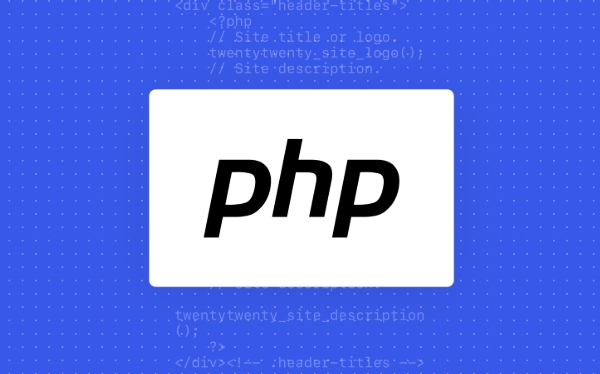 Backend Development
Backend Development
 PHP Tutorial
PHP Tutorial
 Is Your PHP Switch a Code Smell? Identifying and Refactoring Anti-Patterns
Is Your PHP Switch a Code Smell? Identifying and Refactoring Anti-Patterns
Is Your PHP Switch a Code Smell? Identifying and Refactoring Anti-Patterns
Aug 02, 2025 am 08:00 AMYes, the switch statement in PHP itself is not a code smell, but when it is repeated in multiple files, contains too many branches, is tightly coupled with business logic, violates the principle of single responsibility, or makes judgments based on object types, it becomes an anti-pattern; 1. Use policy mode processing factory: define processing interfaces and concrete classes, map types to processors through factory mapping, add new types only requires registration and no modification of existing code; 2. Use class-based distribution (polymorphism): let the object itself determine behavior, implement concrete logic by inheriting abstract classes, and directly execute methods when calling without switching; 3. Use closure mapping (suitable for simple scenarios): Use associative arrays to store the mapping of types to closures, avoid branch structures but are less testable; 4. PHP 8 You can use match expressions to replace simple switches, which are safer and more expressive, but cannot solve the problem of duplication and coupling. The fundamental goal is to avoid switches spreading with business growth. Polymorphism, policy mode or factory mode should be given priority to make the code open to extensions and close to modifications, thereby improving maintainability and testability.

Yes, a PHP switch statement isn't inherently a code smell — it's a valid control structure. But when used excessively, deeply nested, or repeated across your codebase, it can become an anti-pattern that harms maintainability, violents the Open/Closed Principle, and makes testing harder. Let's break down when a switch becomes problematic and how to reflector it effectively.

When a Switch Statement Becomes a Code Smell
A switch can be a red flag in the following situations:
- Repeated across multiple files : You copy-paste the same switch logic in different places (eg, in a controller, service, and DTO).
- Large number of cases : More than 5–6 cases often indicate a need for abstraction.
- Tight coupling to business logic : The switch decides behavior based on type or status, but adding a new case requires modifying multiple switch blocks.
- Violates Single Responsibility Principle : One class or method handles too many responsibilities via switch cases.
- Used with object types or class names : eg,
switch (get_class($object))— this is a classic sign you need polymorphism.
These patterns make your code harder to extend and test. Every time you add a new type or status, you must hunt down every switch and update it — a maintenance nightmare.

Common Anti-Pattern Example
class PaymentProcessor
{
public function process($payment)
{
switch ($payment->type) {
case 'credit_card':
return $this->processCreditCard($payment);
case 'paypal':
return $this->processPayPal($payment);
case 'bank_transfer':
return $this->processBankTransfer($payment);
default:
throw new InvalidArgumentException('Unsupported payment type');
}
}
}Now imagine this same logic is duplicated in validation, logging, or notification systems. One new payment method means updating multiple files — not scalable.
Refactoring Strategies
Here are several clean ways to eliminate switch anti-patterns:

1. Use Strategy Pattern with a Factory
Create an interface for the behavior and individual classes for each type.
interface PaymentHandler
{
public function handle($payment);
}
class CreditCardHandler implements PaymentHandler { /* ... */ }
class PayPalHandler implements PaymentHandler { /* ... */ }
class BankTransferHandler implements PaymentHandler { /* ... */ }Then use a factory to map types to handlers:
class PaymentHandlerFactory
{
private $handlers;
public function __construct()
{
$this->handlers = [
'credit_card' => new CreditCardHandler(),
'paypal' => new PayPalHandler(),
'bank_transfer' => new BankTransferHandler(),
];
}
public function getHandler($type): PaymentHandler
{
if (!isset($this->handlers[$type])) {
throw new InvalidArgumentException("No handler for $type");
}
return $this->handlers[$type];
}
}Now your processor becomes:
class PaymentProcessor
{
private $factory;
public function __construct(PaymentHandlerFactory $factory)
{
$this->factory = $factory;
}
public function process($payment)
{
$handler = $this->factory->getHandler($payment->type);
return $handler->handle($payment);
}
}Adding a new payment type? Just create a new handler and register it — no switch to modify.
2. Replace with Class-Based Dispatching (Polymorphism)
Instead of checking a type string, let the object itself define its behavior.
abstract class Payment
{
abstract public function process();
}
class CreditCardPayment extends Payment { /* ... */ }
class PayPalPayment extends Payment { /* ... */ }Then your processor simply calls:
$payment->process(); // No switch needed
This is the most elegant solution when you control the object hierarchy.
3. Use a Map with Closures (for Simple Cases)
For lightweight logic, you can replace a switch with an associated array of closings:
$handlers = [
'credit_card' => fn($p) => $this->processCreditCard($p),
'paypal' => fn($p) => $this->processPayPal($p),
];
if (!isset($handlers[$type])) {
throw new InvalidArgumentException();
}
return $handlers[$type]($payment);This keeps things simple and avoids branching logic, though it's less testable than full classes.
Bonus: Use Enum with Match (PHP 8)
If you're on PHP 8 , consider using match instead of switch for value mapping — it's safer and more expressive:
return match ($status) {
'draft' => Color::Gray,
'published' => Color::Green,
'archived' => Color::Red,
default => throw new InvalidArgumentException(),
}; But note: match is better syntax, not a design fix. It doesn't solve the underlying coupling issue if you repeat it everywhere.
Bottom Line
A switch isn't evil — it's useful for simple branching or mapping known constants. But when it starts dictating behavior based on types or statuses across your app, it's time to reflector. Favor polymorphism, strategy patterns, or factories to make your code open for extension and closed for modification.
The goal isn't to eliminate every switch, but to avoid letting it becomes a maintenance trap. If you find yourself adding yet another case somewhere — ask: Could this be an object instead?
Basically, if your switch grows with your business logic, it's probably time to evolve it into something more maintained.
The above is the detailed content of Is Your PHP Switch a Code Smell? Identifying and Refactoring Anti-Patterns. For more information, please follow other related articles on the PHP Chinese website!

Hot AI Tools

Undress AI Tool
Undress images for free

Undresser.AI Undress
AI-powered app for creating realistic nude photos

AI Clothes Remover
Online AI tool for removing clothes from photos.

Clothoff.io
AI clothes remover

Video Face Swap
Swap faces in any video effortlessly with our completely free AI face swap tool!

Hot Article

Hot Tools

Notepad++7.3.1
Easy-to-use and free code editor

SublimeText3 Chinese version
Chinese version, very easy to use

Zend Studio 13.0.1
Powerful PHP integrated development environment

Dreamweaver CS6
Visual web development tools

SublimeText3 Mac version
God-level code editing software (SublimeText3)

Hot Topics
 PHP Variable Scope Explained
Jul 17, 2025 am 04:16 AM
PHP Variable Scope Explained
Jul 17, 2025 am 04:16 AM
Common problems and solutions for PHP variable scope include: 1. The global variable cannot be accessed within the function, and it needs to be passed in using the global keyword or parameter; 2. The static variable is declared with static, and it is only initialized once and the value is maintained between multiple calls; 3. Hyperglobal variables such as $_GET and $_POST can be used directly in any scope, but you need to pay attention to safe filtering; 4. Anonymous functions need to introduce parent scope variables through the use keyword, and when modifying external variables, you need to pass a reference. Mastering these rules can help avoid errors and improve code stability.
 How to handle File Uploads securely in PHP?
Jul 08, 2025 am 02:37 AM
How to handle File Uploads securely in PHP?
Jul 08, 2025 am 02:37 AM
To safely handle PHP file uploads, you need to verify the source and type, control the file name and path, set server restrictions, and process media files twice. 1. Verify the upload source to prevent CSRF through token and detect the real MIME type through finfo_file using whitelist control; 2. Rename the file to a random string and determine the extension to store it in a non-Web directory according to the detection type; 3. PHP configuration limits the upload size and temporary directory Nginx/Apache prohibits access to the upload directory; 4. The GD library resaves the pictures to clear potential malicious data.
 Commenting Out Code in PHP
Jul 18, 2025 am 04:57 AM
Commenting Out Code in PHP
Jul 18, 2025 am 04:57 AM
There are three common methods for PHP comment code: 1. Use // or # to block one line of code, and it is recommended to use //; 2. Use /.../ to wrap code blocks with multiple lines, which cannot be nested but can be crossed; 3. Combination skills comments such as using /if(){}/ to control logic blocks, or to improve efficiency with editor shortcut keys, you should pay attention to closing symbols and avoid nesting when using them.
 How Do Generators Work in PHP?
Jul 11, 2025 am 03:12 AM
How Do Generators Work in PHP?
Jul 11, 2025 am 03:12 AM
AgeneratorinPHPisamemory-efficientwaytoiterateoverlargedatasetsbyyieldingvaluesoneatatimeinsteadofreturningthemallatonce.1.Generatorsusetheyieldkeywordtoproducevaluesondemand,reducingmemoryusage.2.Theyareusefulforhandlingbigloops,readinglargefiles,or
 Tips for Writing PHP Comments
Jul 18, 2025 am 04:51 AM
Tips for Writing PHP Comments
Jul 18, 2025 am 04:51 AM
The key to writing PHP comments is to clarify the purpose and specifications. Comments should explain "why" rather than "what was done", avoiding redundancy or too simplicity. 1. Use a unified format, such as docblock (/*/) for class and method descriptions to improve readability and tool compatibility; 2. Emphasize the reasons behind the logic, such as why JS jumps need to be output manually; 3. Add an overview description before complex code, describe the process in steps, and help understand the overall idea; 4. Use TODO and FIXME rationally to mark to-do items and problems to facilitate subsequent tracking and collaboration. Good annotations can reduce communication costs and improve code maintenance efficiency.
 Quick PHP Installation Tutorial
Jul 18, 2025 am 04:52 AM
Quick PHP Installation Tutorial
Jul 18, 2025 am 04:52 AM
ToinstallPHPquickly,useXAMPPonWindowsorHomebrewonmacOS.1.OnWindows,downloadandinstallXAMPP,selectcomponents,startApache,andplacefilesinhtdocs.2.Alternatively,manuallyinstallPHPfromphp.netandsetupaserverlikeApache.3.OnmacOS,installHomebrew,thenrun'bre
 Learning PHP: A Beginner's Guide
Jul 18, 2025 am 04:54 AM
Learning PHP: A Beginner's Guide
Jul 18, 2025 am 04:54 AM
TolearnPHPeffectively,startbysettingupalocalserverenvironmentusingtoolslikeXAMPPandacodeeditorlikeVSCode.1)InstallXAMPPforApache,MySQL,andPHP.2)Useacodeeditorforsyntaxsupport.3)TestyoursetupwithasimplePHPfile.Next,learnPHPbasicsincludingvariables,ech
 How to access a character in a string by index in PHP
Jul 12, 2025 am 03:15 AM
How to access a character in a string by index in PHP
Jul 12, 2025 am 03:15 AM
In PHP, you can use square brackets or curly braces to obtain string specific index characters, but square brackets are recommended; the index starts from 0, and the access outside the range returns a null value and cannot be assigned a value; mb_substr is required to handle multi-byte characters. For example: $str="hello";echo$str[0]; output h; and Chinese characters such as mb_substr($str,1,1) need to obtain the correct result; in actual applications, the length of the string should be checked before looping, dynamic strings need to be verified for validity, and multilingual projects recommend using multi-byte security functions uniformly.





